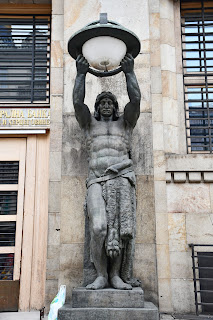Balkans Road Trip: Day 10 – Sarajevo, Travnik, and Banja Luka
We made a second loop around Sarajevo this morning, beginning with a breakfast at a local bakery. Our first stop was Ali Pasha’s Mosque, named after an Ottoman governor of Bosnia in the 16th century. Surrounding the mosque is a small cemetery occupied mostly by the graves of soldiers fallen in the Yugoslav Wars. Many of the tombstones are decorated with what appear to be marble turbans, presumably an indicator of status.
We continued to the
Eternal Flame commemorating Yugoslav fighters against fascism, which stands in
front of the Finance Ministry. The memorial is not far away from the Ashkenazi
Synagogue, which is just across the bridge over the river Miljacka. Also on the
southern side of the river are the Park At Mejdan and the Emperor’s Mosque,
dedicated to Mehmed the Conqueror and the first mosque built after the Ottoman
conquest of Bosnia.
Just north of At
Mejdan, however, is also the Latin Bridge. The humpbacked structure stands at a
historically significant place: it is the last bridge Archduke Franz Ferdinand
ever crossed, as he was assassinated at a corner on the opposite side.
Nowadays, a plaque and two footmarks commemorate the act that started the First
World War. Finally, we toured the City Hall, which was designed by the Czech
architect Karel Pařík in pseudo-Moorish style. The opulent interior of the City
Hall is not to be missed, and the second floor features a good crash course
exhibition on the history of Bosnia.
Returning to our
hostel, I pulled off unparking from the tight garage in a single go, which made
me very proud. Trying to park and unpark has been my theme on this trip, and
the manoeuvre often involved multiple bystanders, annoyed drivers, and
well-intentioned hotel owners. By far the worst parking situations were at
family-run hotels in Split and Dubrovnik, where the hotel owners had to come
out and direct me through my many attempts.
We had initially
planned to drive from Sarajevo straight to Banja Luka, but Yang found a few
places to visit on the way to spice up our journey. Leaving the highway for a
country road, we arrived at the town of Travnik at around noon. Finding a
vegetarian meal proved quite a difficult task, and we entered three different
restaurants before finally settling for a cheese-filled filo pastry and the
Bosnian equivalent of coleslaw.
Travnik has a few
sights worth mentioning, which include the birth house of Nobel Laureate Ivo Andrić
and the Ornamented Mosque. Around the latter are several shops and an
Ottoman-style café with comfily fitted alcoves, where we had some salep and
Bosnian baklava (we were assured Bosnian baklava is quite distinct from the
Turkish kind, and I did indeed find it a little more wet and less compact). Climbing
the hill, we also visited the town’s fortress: Travnik used to be the seat of
Bosnia’s governor during Ottoman rule, though its importance significantly
declined under the Austro-Hungarian Empire.
Although we had also
intended to visit the town of Jajce, we discovered upon reaching the fork that
the road to Jajce was unpaved – and incredibly long. For a while, we forged on
hoping to find another one, but we eventually gave up on this hope and
continued straight to Banja Luka.
We noticed many
strange things on this journey. For one, the state of the road connecting
Sarajevo to Banja Luka is exceedingly poor – I imagine there is a vicious cycle
between the bad connection between the two and continuing political tensions.
Secondly, and relatedly, we have observed since yesterday that every time we
entered Republika Srpska, we were welcomed by the region’s tricolour, whereas
nothing ever alerted us to our arrival in Bosnia.
The landscape also
changed quite significantly as we drove into the northern half of Republika
Srpska: the red-roofed houses and churches perched on hills seemed much more
Central European than the southern reaches of Bosnia that had more in common
with the dramatic Dalmatian coast. However, if I had to compare Banja Luka to
any city, it would be Moscow. Its broad boulevards lined by linden and chestnut
trees, its smartly dressed inhabitants, and its conspicuous showcasing of major
religious buildings belonging to multiple denominations had an almost uncanny
resemblance to Russia’s capital.














































































Comments
Post a Comment